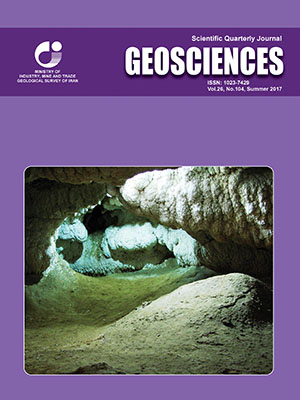Document Type : Original Research Paper
Authors
1 Ph.D. Student, Faculty of Basic Sciences, Islamic Azad University, Shiraz Branch, Shiraz, Iran
2 Associate Professor, Department of Geology, Islamic Azad University, Shiraz Branch, Shiraz, Iran
3 Associate Professor, Department of Geology, Islamic Azad University, Tehran North Branch, Tehran, Iran
4 Associate Professor, Department of Geology, Payame Noor University, Tehran, Iran
Abstract
Lithological and biological Sequences of Cretaceous in Bahar section, Located in South Esfahan (147 m. true thickness) include grayish olive green pencil- like shales containing Budantysras Ammonites (Albian) interbedded with limy shales. which are covered by glauconitic Sandy Limestone (Early Turonian) (with erosional discontinuity). These sandy limestones are wackestone and rarely greenstone, according to Dunham classification. Based on Biozone divisions, this unit is related to Biozone No. 27 presented by Wynd (1965) and it is equivalent to Sarvak Formation in Zagros. Marly limestone and limestone containing Inoceramus bivalve interbedded with marl dating back to Late, Middle Touronian- Late Touronian- Coniacian to Early Santonian are younger equivalents of this section which can be equaled to Surgah Formation. According to Biozone divisions, this unit is equivalent to Biozone No. 28 presented by Wynd (1965) and also based on Dunham classification, the unit is packestone and partly boundstone. The lower Contact of the unit is Concordant and Continuous with glauconitic sandy limestone and its upper Contact is Continuous and Concordant with marl and interbeddings of Limestones dating back to Santonian- Campanian. By comparing Bahar Section with South eastern Lorestan section (Poshte jangal anticline), (Azadbakht, 2015), the following results were obtained: From Litho/bio stratigraphical view, thick to thin-bedded Limestones (Light to dark gray) interbedded with marl in Poshte jangal anticline are Correlated with Inoceramus limestone and marly Limestone interbedded with marl in Bahar Section. They are dated back to EarlyTuronian to Early Campanian.Due to Strong similarity of Lithostratigraphy and biostratigraphy between Bahar section located in Southern Esfahan (Central Iran) and section of Poshte jangal anticline located in Southeast of Lorestan, it can be deducted that a branch of Lorestan Sea has advanced in Turonian- Coniacian times and some parts of Southern Esfahan has been covered by the sea.
Keywords

